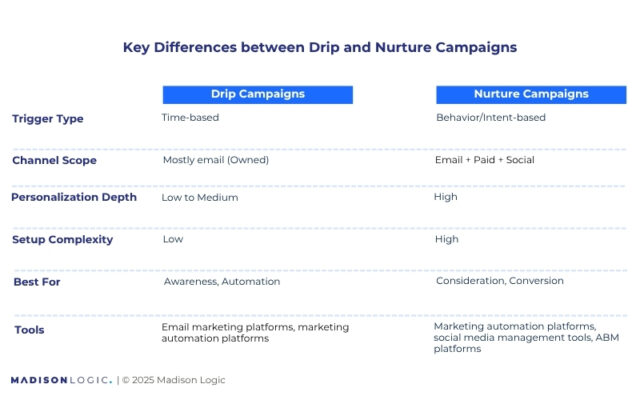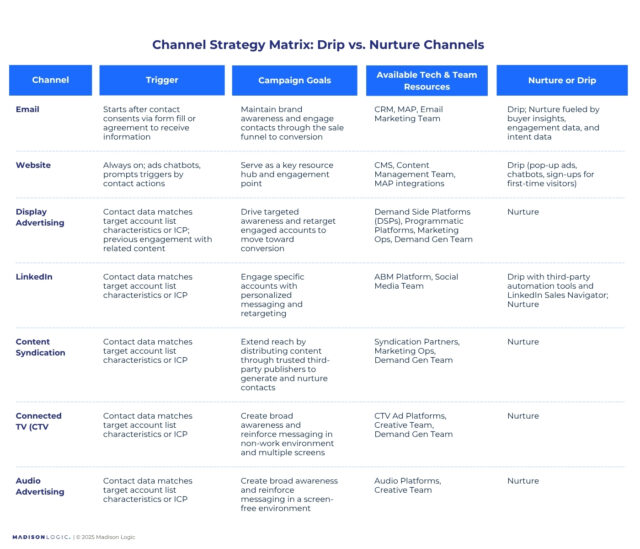
Madison Logic Named the Only Visionary in the 2025 Gartner® Magic Quadrant™ for Account-Based Marketing (ABM) Platforms. Learn More
Madison Logic Named the Only Visionary in the 2025 Gartner® Magic Quadrant™ for Account-Based Marketing (ABM) Platforms. Learn More

In the intricate dance of account-based marketing (ABM), choosing between drip and nurture campaigns isn’t just a tactical decision—it’s a strategic one. Drip campaigns offer the allure of automation and consistency, delivering messages at set intervals. Nurture campaigns, on the other hand, emphasize personalized engagement, adapting to the unique journey of each account. This dichotomy presents a philosophical conflict: should marketers prioritize efficiency or personalization?
Externally, marketers face the challenge of reaching decision-makers inundated with content. Personally, they navigate the complexities of sales and marketing alignment. Internally, they wrestle with doubts about the most effective approach. The ghost of past campaigns that missed the mark lingers, feeding the lie that more automation guarantees success. But the truth is, in ABM, meaningful engagement often trumps sheer volume.
This article delves into the nuances of drip and nurture campaigns within ABM, offering insights to help you strike the right balance and drive impactful results from your lead generation efforts.
Drip campaigns are the dependable workhorses of an email marketing strategy—automated email sequences sent at fixed intervals, often triggered by a specific action like downloading a resource or filling out a form. Their strength lies in consistency: once launched, they deliver timely messages without requiring constant oversight.
In the context of ABM, drip campaigns help you stay in touch and keep your brand top of mind through sequenced touchpoints after a contact agrees to receive further communication from you from registering for a webinar or downloading a whitepaper. The goal of a drip campaign is to take these “warmed up” leads and drive them further into the sales cycle toward conversion without constant oversight from a salesperson. However, there’s ample risk of a hand’s off approach: Drip messages may miss the mark due to generic content.
Modern audiences expect more relevance and personalization from brands, whether it’s from a personal interaction or opting into communications from your website. You need to create drip campaigns based on specific actions that align with your segmentation and lead scoring efforts.
For example, if you set up a drip campaign to trigger after a contact fills out a pricing page request on your website, you will use more bottom-of-funnel content in those emails because asking about pricing shows that this contact is in the consideration stage of the buying journey. Comparatively, someone who signs up for your newsletter will receive content that’s focused more on top-of-funnel messaging, like a selection of recent articles published on the company blog, to continue building out that person’s brand awareness.
These segmented drip campaigns tailored to specific lead scores or actions transform these static flows into more strategic plays, helping you maintain efficiency without losing the human touch.
Some other examples of drop campaigns include:
Where drip campaigns offer structure, lead nurture campaigns offer nuance. Lead nurture campaigns are multi-touch, behavior-driven journeys designed to build trust and guide potential customers through the buying process—on their terms. Rather than follow a fixed schedule, nurture campaigns respond to signals, such as a page visit, a spike in engagement, or a shift in buying stage.
Your lead scoring model and lead segmentation play vital roles in nurture campaigns. Lead scoring helps prioritize which accounts are most likely to convert, while segmentation ensures that messaging and any special initiatives or offers are tailored to specific audiences based on factors like industry, role, or buying stage. Together, they help marketers trigger the right nurture journey at the right time—maximizing impact without wasting resources.
Nurture campaigns shine in an ABM strategy, as they are a coordinated effort that mirrors how buying actually happens across platforms, moments, and stakeholders. For example, a nurture campaign can be activated when a buyer interacts with LinkedIn ads, which triggers tailored email sequences. Marketers can alert sales development representatives (SDRs) about the LinkedIn ad interaction, as well as any website activity to help ensure personalized sales outreach. Done right, nurture campaigns create a sense of presence and partnership with your prospects. But they don’t come easy. Nurture campaigns demand careful orchestration, alignment across teams, and the right technology to scale effectively.
Marketing automation and ABM platforms are essential tools because they enable seamless coordination of multi-channel touchpoints, automate timely and personalized messaging, and provide real-time insights into buyer behavior. These capabilities ensure your campaigns run smoothly and maintain a consistent, relevant experience that feels human at every interaction.
Equally important is the lead handoff—the moment when marketing-qualified leads are passed to sales. A well-executed handoff depends on accurate lead scoring, enriched data, and clear communication powered by these platforms. This ensures sales teams receive highly qualified, contextual leads ready for personalized outreach, improving conversion rates and accelerating the buying journey.
Effective targeting, personalization, and multi-channel nurturing all hinge on one thing: valid leads. Without confidence in the validation process, even the most well-orchestrated campaigns fall flat.
When you know where your leads come from and how they’re validated, you can segment, score, and engage with precision. Download Leading the Charge in Transparency: Elevating Standards in Content Syndication to learn about how to strategically evaluate syndication partners based on their data practices.
When planning your follow-up strategy for leads and accounts, it’s important to understand the key differences between drip and nurture campaigns. Follow the chart below for the key differences between these campaigns, such as their timing, use case, and depth of personalization and effort.

Drip and nurture campaigns serve different functions in an ABM strategy: drip scales your reach (maintaining contact with your audience) through segmented email programs, while nurture deepens engagement by incorporating buyer characteristics, intent signals, and engagement history.
Since drip campaigns require less oversight and can be triggered reliably through automation, they’re a great starting point to build stronger nurture campaigns. Marketers who need more time to develop a nurture strategy can use drip campaigns to experiment with content promotion, audience interest, and segmentation. Knowing when to deploy each helps you build a more connected, responsive buyer experience.
In ABM, it’s not about choosing drip or nurture—it’s about using both in tandem. Drip campaigns maintain communication and awareness of your brand, while nurture campaigns respond to buyer intent and deepen the relationship between the brand and buying committee member. Think of drip campaigns as the beginning of your nurture strategy and build momentum for your contacts to respond positively through nurturing with deeper engagement.
For example, a lead might enter through a drip sequence after downloading a whitepaper. But once they show active interest, like viewing a pricing page or attending a webinar, that behavior can trigger a nurture path with more personalized, cross-channel engagement.
If they’re opening your emails, clicking your ads, or responding to a salesperson’s outreach, they’re already investing time. That’s your cue to shift from passive drip campaigns to active engagement through nurturing. At this stage, it’s essential to deepen the relationship by delivering personalized, relevant content and timely interactions that address their specific needs and concerns.
Successful account-based marketing plans hinge not just on what you say, but where and how often your audience hears you. That’s why integrating owned and paid channels into your drip and nurture strategies is critical. This isn’t just about sending emails or launching LinkedIn ads, it’s about surrounding the buying group and orchestrating coordinated touchpoints that guide them through a complex buying journey.
Owned channels via email, your website, and in-app messaging are where drip campaigns shine. These channels give you control over message timing, frequency, and structure. Drip campaigns on owned channels are ideal for:
In contrast, nurture campaigns often rely on paid channels to meet buyers wherever they are. Later stages in the buying journey require more personalization to stand out and secure more attention from the buying group. Nurture campaigns typically include display advertising, LinkedIn Sponsored Content, YouTube pre-rolls, and other forms of personalized retargeting based on account behavior and intent data. Because B2B buyers love personalization, this integrated approach focuses on buyer’s actions and pain points to deliver relevant ads across multiple channels to inherently boost trust and accelerate the buying journey.
Here are a few examples of how paid channels support nurture campaigns:
When used correctly, paid channels don’t replace your email efforts—they amplify them. They also help reach stakeholders who haven’t yet opted into email, keeping your brand visible even without a direct line of contact.
The true strength of ABM lies in orchestrating drip and nurture campaigns seamlessly across both owned and paid media channels. This unified brand to demand approach drives higher engagement, accelerates conversions, and delivers a more relevant, empathetic experience for each account stakeholder. An integrated approach could look like:
Achieving this level of orchestration requires leveraging intent data providers and ABM platform solutions that unify disparate systems, enabling real-time triggers and insights across channels. Owned channels craft and deliver your core message, while paid channels amplify and surround the right audience with consistent, personalized touchpoints at the moments that matter most.
Together, these combined efforts create a surround-sound marketing experience that’s efficient in execution and empathetic in engagement, and guides every stakeholder through their unique buying journey on their own terms.
A successful nurture strategy in ABM relies on using the right channels at the right stages, distinguishing between drip campaigns that deliver steady, timed messaging and nurture campaigns that respond dynamically to buyer behavior. This matrix outlines how key channels serve as drip or nurture tools, aligned with account stages, campaign goals, technology needs, and target list sizes. Leveraging this framework enables marketers to orchestrate personalized, multi-touch engagement that guides accounts smoothly through their buying journey.

The smartest ABM strategies balance efficiency with empathy by knowing exactly when to automate and when to apply a human touch. Lead nurturing automation powers both drip and nurture campaigns, enabling marketers to deliver consistent, timely messaging at scale without losing the personal relevance that buyers expect.
The ML Platform helps B2B marketers streamline multi-channel nurturing by automating outreach, unifying data, and personalizing content across key channels.
Want help orchestrating drip and nurture journeys? Contact us to learn more about our platform and ABM strategists.